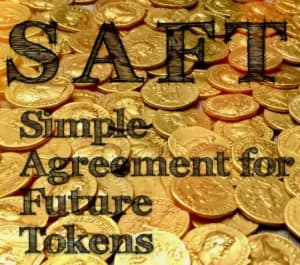
The Securities & Exchange Commission (SEC) has reportedly sent a wave of subpoenas and information requests to companies engaged in Initial Coin Offerings (ICOs). The SEC scrutiny is perhaps not surprising, given that, as Crowdfund Insider writes, “if you invest in an ICO, the play is to speculate on the price of the crypto once it is traded on a cryptocurrency exchange.”¹ The Wall Street Journal has pointed out that SEC scrutiny has focused particularly on the use of “simple agreements for future tokens”, or SAFTs², a point which Coindesk confirmed, quoting a reportedly knowledgeable source, who stated: “The SEC is targeting SAFTs.”³
The irony is that SAFTs were created to reduce regulatory risk for ICO issuers, as reflected in the subtitle of the white paper introducing the SAFT concept, “Toward a Compliant Token Sale Framework”.4 Some of the largest ICOs of all time – such as the ongoing ICO of Telegram, which has so far raised $850 million, with a potential target of $2.5 billion5, and that of Filecoin in 2017, which raised $257 million6 – have utilized SAFT structures for precisely that reason. This article identifies sources of legal and regulatory risk that both SAFT contracts as well as the “utility tokens” issued in their second stage may be securities under U.S. law.
The SAFT Argument
In The SAFT White Paper, SAFTs were promoted as a way for ICO issuers to comply with U.S. securities laws by selling SAFTs only to initial purchasers who were accredited investors, then allowing them to freely re-sell the subsequently-issued utility tokens to retail investors following the network’s completion.7
The rationale for this legal alchemy purportedly lies in the SAFT’s structure. The SAFT itself is a security. It is a contract giving the purchaser the right to receive the issuer’s tokens that will be issued in the future, and is sold to accredited investors in a Rule 506(c) private offering, for which the issuer files a Form D. The issuer then uses the  proceeds raised by the SAFT sale to finance the development of its software network. Once development is completed, the issuer issues and delivers now fully-functional utility tokens, useable on its network, to the original SAFT holders. SAFT proponents argue that the tokens are not securities and therefore purchasers can freely re-sell the utility tokens to retail investors without being deemed to have facilitated an unregistered securities offering, acted as unregistered broker-dealers or violated mandatory holding periods, while intermediaries – such as trading platforms listing such tokens for trading – would not have an SEC registration obligation.
proceeds raised by the SAFT sale to finance the development of its software network. Once development is completed, the issuer issues and delivers now fully-functional utility tokens, useable on its network, to the original SAFT holders. SAFT proponents argue that the tokens are not securities and therefore purchasers can freely re-sell the utility tokens to retail investors without being deemed to have facilitated an unregistered securities offering, acted as unregistered broker-dealers or violated mandatory holding periods, while intermediaries – such as trading platforms listing such tokens for trading – would not have an SEC registration obligation.
The SAFT’s proponents argue that post-completion utility tokens that have a functional use on a software network would not be securities, even though the initial SAFT contracts would be. When the SAFT is sold, no network exists, meaning that whether there will ever be a network depends solely on the issuer’s future managerial and entrepreneurial efforts in using the proceeds raised by the SAFTs’ sale to develop the network. However, when network development is completed, the utility tokens issued following completion purportedly do not rely on the managerial or entrepreneurial “efforts of others” to derive their value.
Instead, the tokens’ value arises from one of two sources, neither of which, proponents argue, flunk the Howey test. First, the value of functioning utility tokens does not derive from their investment potential but rather from the value offered by their consumptive use as, e.g., coupons redeemable for goods and services from the issuer. As Filecoin’s Private Placement Memorandum for its SAFT contracts put it:
Filecoin is a utility token that has a specific consumptive use – i.e. it allows participants in the Filecoin Network to obtain file storage, and make file storage available, on a distributed network… Due to the nature of Filecoin, we do not think it should be considered a “security”.8
Second, even if utility token holders expect to derive profit from their value as investments, the “essential” influences on such expectations are commodity-like market forces affecting industry-specific supply and demand, the same way forward sale contracts for sugar are influenced by the dynamics of the world sugar market, not expectations based on the issuer’s future managerial or entrepreneurial efforts.
The SEC’s Stance on Utility Tokens
In the months since the release of The SAFT White Paper, the SEC has made a number of public statements that seem directly targeted at the SAFT model and its reliance on the argument that utility tokens are commodities, not securities.
a) Munchee Enforcement Action
 In the SEC’s most high-profile enforcement action – In the Matter of Munchee, Inc.9 – alleging registration violations against a utility token issuer, the SEC was not persuaded that the purported utility tokens were not securities.
In the SEC’s most high-profile enforcement action – In the Matter of Munchee, Inc.9 – alleging registration violations against a utility token issuer, the SEC was not persuaded that the purported utility tokens were not securities.
The SEC made two distinct sets of arguments. First, the SEC argued they effectively were not bona fide utility tokens, because they were not marketed to persons in the restaurant industry, such as consumers who would have used them to pay for food purchases or to increase their ranking (“tier”) as restaurant reviewers, or restaurants who would have used them to pay for advertising targeting such consumers, but rather were specifically targeted at financial investors on social media and message boards catering to Bitcoin and cryptocurrency investment.
Agents acting on behalf of the issuer touted the tokens’ financial performance relative to other cryptocurrency investments. The issuer promised to maintain secondary markets on which such investors could re-sell its tokens by listing them on a U.S.-based exchange within 30 days of their sale, long before the network had been built, and to take action to increase the tokens’ value, such as by periodically “burning” them (taking out of circulation), to reduce their supply. The issuer promised that profits would come, not from using the token to participate in the Munchee eco-system (such as by getting discounts on meals), but rather from passively holding the tokens, consistent with their being investments. At the time they were sold, the Munchee tokens could not be used to buy goods or services as no network had been built yet.
Second, even if they had been bona fide utility tokens, the expectation of profits likely would have stemmed from the issuer’s managerial and entrepreneurial efforts in hiring persons to design and write the network’s code, attracting and retaining a nexus of willing participants (restaurants and reviewers) through promotional efforts targeting them, supporting a secondary market for the tokens and reducing the number in circulation, and – in general – creating a critical mass around which an eco-system could form; once built, the issuer would then maintain the network on an ongoing basis, given it was not open-source.
Even if the increase in the tokens’ value was commodity-like –, i.e. due to a rise in token usage demand compared to a fixed10 token supply – the key factor in creating the conditions necessary for demand to rise in the first place (such as there being a network and an eco-system of participants at all in which the tokens could be used), was due to the issuer’s managerial and entrepreneurial efforts. In the SEC’s view, the issuer’s role setting up the eco-system could possibly be enough by itself, notwithstanding the tokens’ marketing, to satisfy the “efforts of others” prong of the Howey test and thus independently cause the tokens to be securities.
b) SEC Chief Accountant Wesley Bricker’s “Claim Against” Test
We would like to draw readers’ attention to is an important programmatic statement made by a key SEC official that, curiously, appears to have escaped press coverage and market attention. On December 4, 2017, SEC Chief Accountant Wesley Bricker articulated a key test11 for classifying distributed ledger-based assets, defining two terms – “token” and “coin”. He stated that the term “token” refers to “a claim against an entity (or against its assets, cash flows, residual value, [or the entity’s] future goods or services…)”. Being designated a “token” means that the instrument may be a security.
On the other hand, Chief Accountant Bricker defined “coins” as being “a certain feature of a distributed ledger software program…. [that] may be exchanged among the parties.” In other words, coins serving merely as an exchangeable unit of account or store of value, without representing a claim against any entity or entity’s assets – like Bitcoin, which is famously “not backed by anything”12 – would be “coins” under SEC Chief Accountant Bricker’s classification scheme, not at risk of being securities. This matches Bitcoin’s real-life regulatory posture: both the SEC and the CFTC have publicly stated that Bitcoin is not a security, but a commodity.13
Our view – additional reasons for caution
2) Timing of utility token issuer’s efforts
Regarding The SAFT White Paper’s argument about the timing of the token issuer’s managerial efforts, we refer the reader to the able discussion of the issue contained in Research Report #1: Not So Fast—Risks Related To The Use Of A “SAFT” For Token Sales, by the Cardozo Blockchain Project (“The Cardozo Report”). The Cardozo Report’s basic conclusion is that there is a lack of meaningful support in existing law for The SAFT White Paper’s distinction between a utility token issuer’s pre-completion, pre-token-issuance efforts (which involve creating the software network) and the issuer’s post-completion, post-token-sale efforts (none, other than maintenance) when conducting a securities analysis. The overwhelming weight of authority holds that there is no such pre- and post-issuance distinction for Howey “efforts of others” purposes. Pre-issuance efforts by the issuer flunk the Howey test just as much as post-issuance efforts do.
The Cardozo Report’s authors found that the only existing case adopting the approach advocated by SAFT proponents is the D.C. Circuit’s decision in SEC v. Life Partners, Inc. Yet Life Partners, which involved viatical settlement contracts, presented very peculiar circumstances and, in any case, has been rejected by virtually every other court to consider the issue, as well as the SEC.
2) The overall structure of the SAFT arrangement indicates that the utility tokens will almost always be securities
The fundamental issue with the SAFT construct is, if utility tokens are just tokenized representations of physical assets, why is there a need to pre-sell them using a SAFT structure? We believe that the role of the issuer in transforming nothing into something by building from scratch the network on which utility tokens can be used, using the proceeds reaped from the sale of SAFTs, is the fundamental structural problem of the SAFT model from a securities regulatory perspective.
 Simply put, a SAFT arrangement is an investment contract whose value depends on how successful an issuer is in constructing a software network. Issuance of tokens is the final stage of an investment contract-type relationship. Much had to happen before the utility tokens became useable – the issuer had to first actually build the network, the costs of which were financed with the proceeds of a prior capital raise (the SAFT sale). Investors play a well-recognized role in such an arrangement – “one of providing capital with the hopes of a favorable return.”
Simply put, a SAFT arrangement is an investment contract whose value depends on how successful an issuer is in constructing a software network. Issuance of tokens is the final stage of an investment contract-type relationship. Much had to happen before the utility tokens became useable – the issuer had to first actually build the network, the costs of which were financed with the proceeds of a prior capital raise (the SAFT sale). Investors play a well-recognized role in such an arrangement – “one of providing capital with the hopes of a favorable return.”
Without the issuer’s efforts in first building the network on which the tokens can be used, the tokens have no value of any kind. Any value that the utility tokens have, before a network on which they can be used exists, can only be value that is derived from speculative expectations investors have that the issuer will later be successful in building a network that doesn’t currently exist and won’t and can’t exist except through the issuer’s entrepreneurial activity. This is a purely speculative investment motive, of the same kind that underlies the purchase of any security, and it depends on an assessment of the issuer’s management team.
Before the network is built (or has reached its final stage), the question is, will the issuer be able to overcome technical hurdles? In the future, will increased competition interfere with the issuer’s ability to attract or retain a sufficient critical mass of participants needed to have a functioning ecosystem? In the future, will the issuer’s product be sufficiently differentiated or desirable, or its technology sufficiently superior, compared to the competition, that it will survive competitive pressures? When SAFTs are sold, the issuer’s network may not have a history of generating any revenues at all, let alone profits net of expenses. In the future, will the issuer succeed in the quest to generate revenues and achieve profitability? Questions of this nature affect an investor’s willingness to buy the issuer’s SAFTs and to receive in return speculative future tokens for something that doesn’t yet and may not ever be worth anything when it does exist. These are also the exact same types of questions that investors ask themselves before they buy stock or bonds.
There is endless precedent proving that a financial instrument whose value arises from expectations regarding the success or failure of the issuer’s entrepreneurial efforts is a security, regardless of the form or purported label applied to the financial instrument. This holds equally true where the instruments are contracts of sale for commodities. For instance, in Glen-Arden Commodities, Inc. v. Constantino, which involved a promoter’s sales of Scotch whiskey warehouse receipts, the promoter would, among other things, utilize its expertise in selecting the most profitable type and quality of whiskey to be purchased which would permit investors to “double their money” in four years. The promoter argued that “they were engaged in the sale of commodities”, not securities, and thus, were not subject to SEC jurisdiction. The court framed the issue as:
whether the customers were in fact purchasing simply warehouse receipts, akin to a commodity future, or whether, in light of the economic reality and the totality of circumstances surrounding the sales here, the customers were making an investment… [in] an ‘investment contract’.
It found that the investments were securities because the actions of the promoters, including the exercise of the promoters’ expertise in selecting which whiskey to purchase from the standpoint of optimum profitability, involved “services absolutely necessary to the turning of the promised profit”, and the investor had “entrust[ed] the promoters with both the work and the expertise to make the tangible profit pay off.” As discussed above, these are the sort of services that issuers of SAFTs are expected to render during the gap between the sale of the SAFTs, at which time no network exists at all, and the completion of the network, at which point the utility tokens will be issued. Only if the issuer succeeds in overcoming technical hurdles and building the network, and the network succeeds in overcoming competition, will the tokens be valuable. Without the issuer’s indispensable efforts to build a network on which the tokens can be used and defeating competition, the tokens would be completely worthless – just as, in another commodity contracts case that the court deemed to constitute securities, Continental Market Corp. v. Sec. & Exch. Comm’n, “[i]f the structure collapsed then the purchasers would have little more than a bad investment.”
Conclusion
 This article set out to identify sources of legal and regulatory risk that both SAFT contracts as well as the “utility tokens” issued in their second stage may be securities under U.S. law. To recap the arguments made in this paper:
This article set out to identify sources of legal and regulatory risk that both SAFT contracts as well as the “utility tokens” issued in their second stage may be securities under U.S. law. To recap the arguments made in this paper:
- the analysis contained in the SEC’s Munchee enforcement action shows that the way the SEC interprets the term “efforts of others” for Howey purposes covers utility tokens,
- the arguments from The Cardozo Report show that there is no meaningful support in securities jurisprudence for making a distinction between an issuer’s pre-utility-token-issuance and post-utility-token-issuance entrepreneurial efforts, and
- an investor’s willingness to purchase SAFTs (at a time when no network exists on which utility tokens could be used) is based entirely on the expectation that the issuer will successfully utilize the proceeds of the SAFT sale to develop a network on which utility tokens can be used and that will overcome competition (and that such tokens have no value unless the investor has such an expectation).
When attempting to decipher why the SEC might consider SAFT contracts and their associated utility tokens to be securities, and why the agency reportedly sent subpoenas to so many ICO market participants, token issuers, and even their law firms, we believe that the above arguments offer a good starting point.
By and large, existing law does not appear to allow SAFTs, or their later-issued utility tokens, to escape regulation as securities or compliance with the securities laws. Of course, given the recent Congressional attention to the issue, existing law may change, or the SEC may voluntarily decide to establish some kind of remediation program for SAFT offerings that have already closed. But until and unless existing law does change, potential SAFT issuers will need to address the arguments enumerated above in considering their options.
 David Felsenthal is a partner at Clifford Chance, resident in the firm’s New York office. His practice focuses on trading, structured transactions, fintech and financial regulation. He has worked extensively on a range of derivatives – including derivatives linked to credit, foreign exchange, interest rates and equities – and other financial transactions, such as structured securities, repos and securities lending. His fintech experience involves blockchain, shared ledgers and regTech.
David Felsenthal is a partner at Clifford Chance, resident in the firm’s New York office. His practice focuses on trading, structured transactions, fintech and financial regulation. He has worked extensively on a range of derivatives – including derivatives linked to credit, foreign exchange, interest rates and equities – and other financial transactions, such as structured securities, repos and securities lending. His fintech experience involves blockchain, shared ledgers and regTech.
 Jesse Overall is an associate at Clifford Chance. He represents issuers and underwriters in public and private initial and follow-on offerings of equity and debt securities, banks and hedge funds in secondary market par and distressed debt trading, and sponsors of and liquidity providers to securitization vehicles in connection with transactions and regulation applicable to their activities. While in law school at Georgetown, Jesse served as a two-semester intern at the CFTC, in the Divisions of Swap Dealer and Intermediary Oversight and Enforcement, and as a two-semester intern at the SEC, in the Division of Corporation Finance and in the Office of International Affairs.
Jesse Overall is an associate at Clifford Chance. He represents issuers and underwriters in public and private initial and follow-on offerings of equity and debt securities, banks and hedge funds in secondary market par and distressed debt trading, and sponsors of and liquidity providers to securitization vehicles in connection with transactions and regulation applicable to their activities. While in law school at Georgetown, Jesse served as a two-semester intern at the CFTC, in the Divisions of Swap Dealer and Intermediary Oversight and Enforcement, and as a two-semester intern at the SEC, in the Division of Corporation Finance and in the Office of International Affairs.
1 https://staging-crowdfundinsider.kinsta.cloud/2018/03/129341-us-crowdfunding-platforms-will-become-broker-deals-may-become-atss/
2 https://www.wsj.com/articles/sec-launches-cryptocurrency-probe-1519856266?mod=searchresults&page=1&pos=1
3 https://www.coindesk.com/sec-going-saft/
4 https://saftproject.com/static/SAFT-Project-Whitepaper.pdf
5 https://www.nytimes.com/2018/03/04/technology/telegram-initial-coin-offering.html
6 https://www.coindesk.com/257-million-filecoin-breaks-time-record-ico-funding/
7 See fn.4, supra.
8 https://coinlist.co/assets/index/filecoin_index/Protocol%20Labs%20-%20SAFT%20-%20Private%20Placement%20Memorandum-bbd65da01fdc4a15219c49ad20fb9e28681adec9fae744c41cccd124545c4c73.pdf , at 14.
9 https://www.sec.gov/litigation/admin/2017/33-10445.pdf
10 Of course, Munchee’s promise to engage in an active monetary policy by “burning” tokens does not resemble a passive commodity.
11 https://www.sec.gov/news/speech/bricker-2017-12-04
12 https://www.coindesk.com/forget-gold-bitcoin-is-backed-by-time/
13 To our knowledge, to date, Bitcoin is the only such distributed ledger-based asset to have been so recognized.
14 Published November 21, 2017, and available online at https://cardozo.yu.edu/sites/default/files/Cardozo%20Blockchain%20Project%20-%20Not%20So%20Fast%20-%20SAFT%20Response_final.pdf
15 87 F.3d 536 (D.C. Cir. 1996).
16 Continental Market Corp. Sec. & Exch. Comm’n, 387 F.2d 466, 470 (10th Cir. 1967)
17 493 F.2d 1027,1034-35 (2d. Cir. 1974).
18 Id., at 1034.
19 Id.
20 Id. at 1035.
21 Supra fn.16, at 471.
22 See, e.g., Liquid M Capital, Petition for Rulemaking Regarding ICO Remediation, available online at https://www.sec.gov/rules/petitions/2018/petn4-719.pdf

